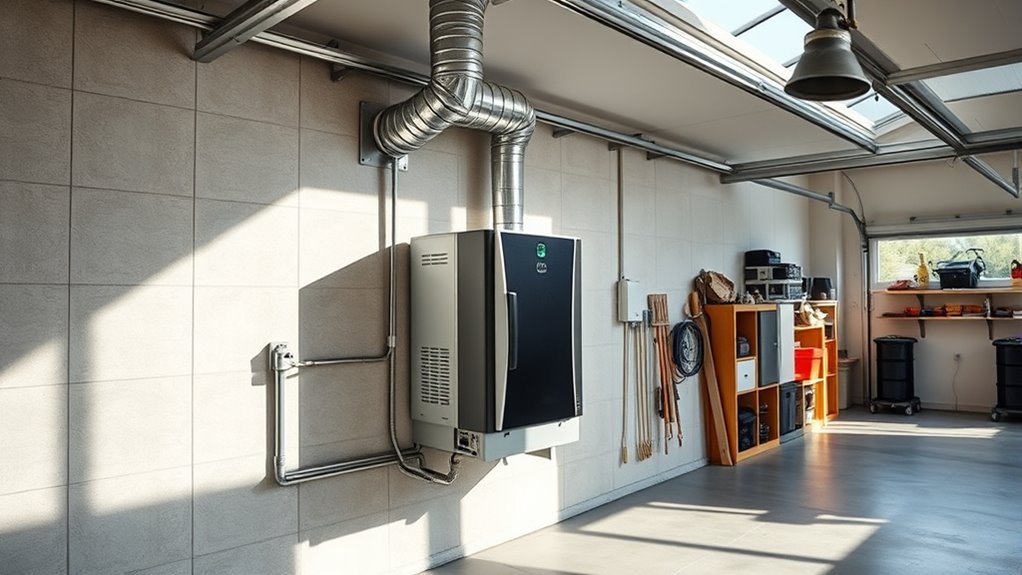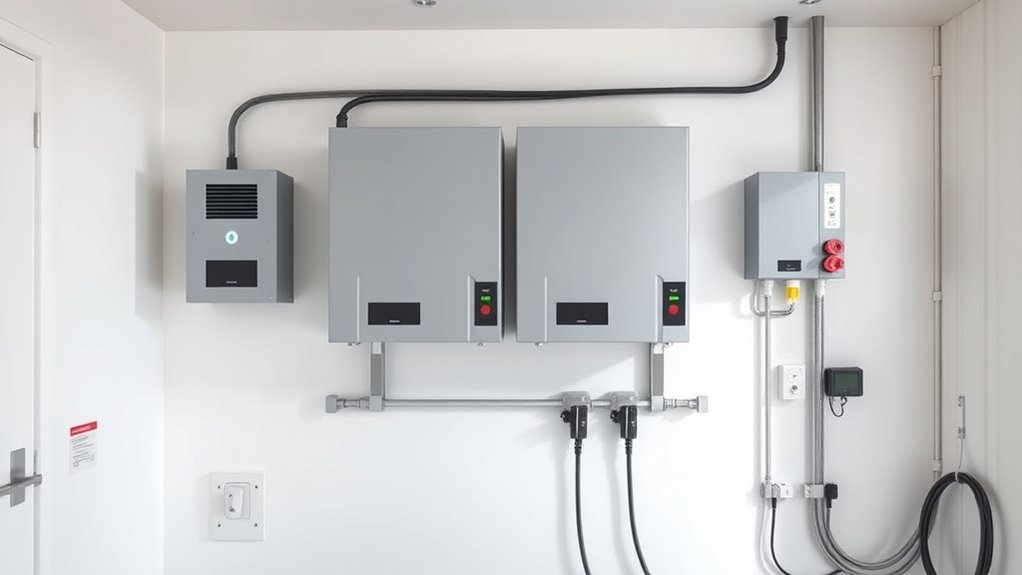To guarantee fire safety for your home energy storage, start by having qualified professionals install certified equipment and verify proper placement with good ventilation. Regularly inspect your system for damage, leaks, or corrosion, and keep safety devices like smoke detectors and fire suppression systems in place. Use fire-resistant barriers and materials around storage units, and develop an emergency plan. Staying informed about safety measures helps protect your home—continue for more practical safety steps.
Key Takeaways
- Ensure proper, certified installation by qualified professionals following local safety codes.
- Regularly inspect batteries and wiring for damage, corrosion, and overheating signs.
- Place storage units in well-ventilated, fire-resistant areas away from heat sources.
- Install smoke detectors and fire suppression systems near energy storage areas.
- Educate household members on emergency procedures and maintain clear access to monitoring systems.
Proper Installation and Professional Assessment

Since improper installation can considerably increase fire risks, it is crucial to have your home energy storage systems installed by qualified professionals. A professional assessment ensures that your system meets safety standards and local codes, reducing the likelihood of electrical faults or overheating. Certified installation guarantees that skilled technicians follow industry best practices, properly securing connections and placing the system in a safe location. Proper installation also includes adherence to recommended characteristics of a healthy system, which are essential for safety and efficiency. Ensuring your system has adequate ventilation and cooling can prevent overheating and potential fire hazards. Incorporating load‑planning tools can help you determine the appropriate system size and avoid overloads that might lead to fires. Additionally, the presence of a reliable home security system can provide an extra layer of safety by alerting you to any unusual activity or malfunctions. Regular system maintenance and inspections by professionals can identify potential issues before they become serious threats. By prioritizing professional assessment and certified installation, you enhance your home’s safety and ensure your energy storage system operates efficiently. Remember, investing in expert services isn’t just about compliance — it’s about protecting your home and loved ones from potential fire hazards.
Choosing Certified and Quality Equipment

When selecting energy storage equipment, make sure it meets recognized certification standards to guarantee safety and reliability. Check the materials used for durability, as high-quality components can better withstand heat and prevent fires. Prioritizing certified, well-made devices helps protect your home and loved ones from potential hazards. Embracing attention in practice by carefully evaluating the equipment can further ensure the safety and effectiveness of your energy storage system. Additionally, selecting models with advanced safety features can provide extra protection against electrical faults or overheating. Incorporating sound design principles into safety assessments can help identify potential vulnerabilities and improve system resilience. Being aware of the specific security assessment techniques involved in evaluating such systems can also inform your choices for safer systems.
Verify Certification Standards
To guarantee your home energy storage system operates safely and reliably, it’s essential to verify that the equipment complies with established certification standards. Ensuring safety compliance helps prevent hazards like fires or failures. Start by checking for recognized certification labels from reputable organizations, such as UL or IEC. Confirm that the system meets local electrical codes and safety regulations. Don’t overlook the importance of documentation that proves adherence to certification standards. Additionally, understanding certification processes can help you appreciate the importance of proper certification and testing procedures. Staying informed about the latest developments in AI detection methods can also support ongoing safety assessments and technological updates in energy storage systems. For example, selecting certified products from reputable manufacturers ensures that your energy storage solutions have undergone rigorous safety testing and meet necessary standards. Moreover, reviewing top-rated products can guide you toward choosing reliable and certified equipment.
Assess Material Durability
How can you guarantee your home energy storage system withstands daily use and environmental factors? By prioritizing material testing and durability assessment, you ensure you’re choosing equipment built to last. Certified products undergo rigorous testing for thermal stability, corrosion resistance, and mechanical strength, reducing fire risks. Selecting durable materials minimizes degradation over time, preventing potential failures. Additionally, understanding the specific requirements for different battery types, such as thermal management, can further enhance safety and longevity. Here’s a quick overview:
| Material Type | Testing Focus | Certification Level |
|---|---|---|
| Lithium-ion | Thermal, mechanical stress | Certified |
| Lead-acid | Corrosion, lifespan | Approved |
| Flow batteries | Chemical stability | Accredited |
| Solid-state | Temperature resilience | Verified |
| Battery enclosures | Impact, weatherproof | Certified |
Invest in quality equipment to protect your home and loved ones, ensuring safety through diligent material testing and durability assessment. Material durability plays a crucial role in maintaining system integrity over the long term. Regular inspections and adherence to industry standards can further ensure ongoing safety and performance.
Regular Inspection and Maintenance Routines

To keep your energy storage system safe, you should schedule regular checks to catch issues early. During these inspections, look for any signs of damage or wear on the batteries and wiring. Also, make sure to clean the battery area to prevent dust and debris from causing problems. Additionally, refer to manufacturer guidelines for recommended maintenance routines to ensure optimal performance and safety. Incorporating thermal management practices can help maintain consistent operating temperatures and prolong system lifespan. Paying attention to battery health monitoring can further improve safety by detecting potential faults before they develop into serious hazards. Regularly updating your knowledge on emerging technologies can help you understand how innovations might influence future energy storage solutions and safety protocols.
Schedule Routine Checks
Regularly scheduling inspections and maintenance is essential for guaranteeing your home energy storage system remains safe and reliable. Consistent checks help identify potential issues that could increase battery fire risks or compromise emergency preparedness. During these routine inspections, you should:
- Verify that ventilation and cooling systems are functioning properly to prevent overheating.
- Examine connections and wiring for signs of corrosion, wear, or damage.
- Test safety devices like fire suppression systems and alarms to ensure they operate correctly.
Inspect for Damage
Inspecting for damage is a critical step in maintaining your home energy storage system’s safety and performance. Regularly examine your batteries and connections for visual damage, such as cracks, dents, or swelling. Look closely for corrosion signs around terminals, wiring, and connectors, which can indicate potential issues. Address any corrosion promptly to prevent further deterioration or electrical faults. Check for discoloration or residue that might suggest leaks or overheating. Keep an eye out for loose or frayed wires, as these increase fire risk. Consistent visual inspections help you catch problems early, reducing the chance of fire hazards or system failure. By staying vigilant and performing these routine checks, you ensure your energy storage remains safe and reliable.
Clean Battery Areas
Cleaning the battery area is essential for maintaining ideal performance and preventing fire hazards. A clean workspace reduces the risk of dust, debris, or accidental spills that could cause shorts or fires. Regular inspection and maintenance help you identify potential issues early. To keep your battery area safe, focus on clutter control and ensuring proper ventilation.
- Remove unnecessary items to maintain a clutter-free environment
- Wipe down surfaces with a damp cloth to eliminate dust and grime
- Check for corrosion or leaks and address them promptly
Correct Ventilation and Placement of Storage Units

Have you considered how proper ventilation and strategic placement can prevent fire hazards in your home energy storage units? Effective ventilation strategies help dissipate heat buildup, reducing the risk of thermal runaway. Ensure your storage units are placed in well-ventilated areas, away from confined spaces or flammable materials. Avoid stacking batteries or placing them near heat sources; instead, position them in cool, dry locations with good airflow. Keep vents unobstructed and consider installing dedicated ventilation systems if needed. Proper storage placement not only minimizes fire risks but also makes monitoring easier. Regularly check for dust, debris, or corrosion around your units, and maintain clear access for inspections or emergency responses. Combining ventilation strategies with thoughtful placement considerably enhances your home’s safety.
Implementing Fire-Resistant Barriers and Materials

To enhance fire safety around your home energy storage units, implementing fire-resistant barriers and using materials designed to withstand high temperatures is essential. Fire resistant barriers can contain or slow the spread of flames, providing vital extra time during a fire. Incorporate flame retardant materials into storage enclosures and surrounding structures to reduce ignition risk. Consider these options:
- Installing fire resistant barriers made from non-combustible materials around storage units
- Using flame retardant coatings on walls and cabinetry
- Selecting storage containers with built-in fire-resistant features
These measures help prevent fires from spreading and protect your home. Combining barriers with flame retardant materials creates a robust defense, considerably lowering fire hazards associated with energy storage systems.
Installing Smoke Detectors and Fire Suppression Devices

Installing smoke detectors and fire suppression devices is a critical step in safeguarding your home energy storage system. A reliable fire detector quickly alerts you to smoke or heat, allowing prompt action to prevent a fire from spreading. Place smoke detectors near your energy storage area and on every level of your home for thorough coverage. Additionally, consider installing a dedicated suppression system designed for electrical fires or battery fires. These systems can automatically activate to suppress flames and reduce damage. Regularly test and maintain your fire detector to ensure it functions correctly, and inspect your suppression system for any signs of wear or damage. Taking these steps minimizes the risk of fire and enhances your home’s overall safety.
Developing a Fire Emergency Plan for Your Home

How prepared are you to handle a fire emergency in your home? Developing a clear fire emergency plan is essential. Start by identifying two escape routes from each room and practicing your home escape regularly. Make certain everyone knows how to quickly reach emergency contacts, including local fire services and trusted neighbors. Write down your plan and keep it accessible. Consider including:
Be prepared with clear escape routes and practiced plans to ensure safety during a home fire emergency.
- Clear escape routes mapped out in your home
- A designated safe meeting spot outside
- A list of emergency contacts and important information
Practicing your plan helps identify potential obstacles and keeps everyone prepared. Remember, a well-thought-out plan minimizes chaos during an emergency and increases your chances of a safe escape. Staying proactive is key to protecting your home energy storage system and loved ones in a fire.
Educating Household Members on Safety Procedures

Once you have a fire emergency plan in place, making sure everyone understands it is the next critical step. You can achieve this by conducting regular household drills, so everyone knows how to respond quickly and safely. Practice different scenarios, including fire in the storage area, to reinforce procedures. Use clear safety signage around your home to remind everyone of important safety steps and escape routes. Explain the purpose of safety signage during drills, so household members recognize key instructions and hazards. Encourage questions and feedback to ensure clarity. When everyone is familiar with the plan and signage, you’ll build confidence and reduce panic during an actual emergency. Consistent education keeps safety top of mind and helps protect your home and loved ones.
Monitoring System Performance With Smart Technology

To guarantee your home energy storage system operates safely and efficiently, leveraging smart technology for monitoring performance is essential. With remote monitoring, you can keep an eye on system health from anywhere, reducing risks of malfunction or fire. Real-time alerts notify you immediately of any irregularities, such as temperature spikes or voltage fluctuations, allowing swift action. Using advanced monitoring systems, you can:
- Continuously track system metrics and identify issues early
- Receive instant notifications for anomalies or potential hazards
- Access detailed performance reports to optimize safety and efficiency
Frequently Asked Questions
How Often Should I Replace or Upgrade My Energy Storage System?
You should consider replacing or upgrading your energy storage system every 10 to 15 years, depending on your battery lifespan and usage. Regularly monitor its performance and look for signs of aging, such as reduced capacity or safety concerns. Upgrading frequency varies based on technological advancements and your energy needs. Staying proactive guarantees safety and efficiency, while also maximizing your investment in reliable, modern energy storage solutions.
What Are the Signs of Potential Fire Hazards in Storage Units?
Irony strikes when your storage unit warns you with signs of fire hazards. Look out for swelling, strange odors, or discoloration—these are clues to thermal runaway or short circuits. Sparks, burning smells, or overheating batteries aren’t just minor issues; they signal real danger. Regular inspections help catch these signs early, preventing potential fires. Stay vigilant, and don’t ignore any warning signs—your safety depends on it.
Can Outdoor Storage Units Be Safer Than Indoor Ones?
Outdoor storage units can be safer than indoor ones because they’re exposed to natural ventilation, reducing fire risk from overheating. However, safety considerations like protection from weather, vandalism, and proper fire-resistant materials are vital. You should make certain outdoor units are well-maintained, secured, and compliant with safety standards. While outdoor units offer some advantages, carefully weigh factors like environmental exposure and accessibility to determine the safest option for your needs.
Are There Specific Fire Safety Regulations for Home Energy Storage?
Fire safety regulations focus fiercely on ensuring your energy storage system stays safe. You must comply with local fire code regulations, which dictate safe distances, proper ventilation, and fire-resistant materials. Staying in safety compliance helps prevent potential fires, protecting your property and loved ones. Always check with local authorities or professionals to guarantee your home energy storage aligns with the latest safety standards, keeping your home secure and sound.
How Do Weather Conditions Affect the Safety of Storage Batteries?
Weather conditions critically impact your storage batteries’ safety. Extreme temperatures cause thermal expansion, which can damage internal components or lead to short circuits. Moisture ingress from rain or humidity can cause corrosion and electrical faults. To protect your batteries, make certain proper ventilation, keep them in a dry, climate-controlled environment, and regularly inspect for signs of moisture or damage. Proper precautions help prevent fire hazards and prolong your batteries’ lifespan.
Conclusion
By following these steps, you can make your home energy storage as safe as a fortress. Regular maintenance, proper placement, and staying informed are your best defenses against fire risks. Think of it like tending a garden—you need to nurture and monitor it to keep everything thriving. Stay proactive, educate your household, and use smart technology to keep your home secure. Safety isn’t just a plan; it’s your shield against unexpected fires.









